Related Research Articles

Portland Public Library is the main library of the public library system in Portland, Maine, USA. It is located at 5 Monument Square on Congress Street in the Old Port of Portland, Maine. The library has three neighborhood branches, Burbank branch, Peaks Island branch, and Riverton branch.

The Time and Temperature Building, originally known as the Chapman Building, and officially 477 Congress Street, is a 14-story office building on Congress Street in downtown Portland, Maine. The building, which replaced Preble House, is named after a large three-sided four-element eggcrate display screen on the roof that flashes the local time and temperature. It was built in 1924 as a 12-story building, with Maine's first indoor shopping center on its ground floor. It sits across Preble Street from the 10-story Fidelity Trust Building. Until the 1970s, these buildings were Portland's only skyscrapers.
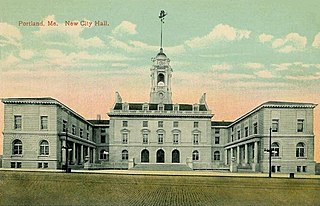
Portland City Hall is the center of city government in Portland, Maine. The fourth city hall built in Portland, it is located at 389 Congress Street, on a prominent rise, anchoring a cluster of civic buildings at the eastern end of Portland's downtown. The structure was built between 1909 and 1912 and was listed on the National Register of Historic Places in 1973.

The Maine Historical Society is the official historical society of the U.S. state of Maine. It is located at 489 Congress Street in downtown Portland. The Society currently operates the Wadsworth-Longfellow House, a National Historic Landmark, Longfellow Garden, the Maine Historical Society Museum and Store, the Brown Research Library, as well as the Maine Memory Network, an online database of documents and images that includes resources from many of state's local historical societies.

Lincoln Park is a 1.8-acre (0.73 ha) urban park in downtown Portland, Maine. Created as Phoenix Square in 1866, following that year’s Great Fire, which burned down most of the buildings of Portland, it was renamed on January 24, 1867, in honor of former president Abraham Lincoln. It is bounded by Congress Street to the west, Pearl Street to the south, Federal Street to the east and Franklin Street to the north. The park was added to the National Register of Historic Places in 1989.
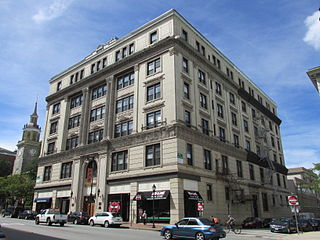
The Masonic Temple is a historic commercial and fraternal society building at 415 Congress Street in downtown Portland, Maine. Built in 1911 to a design by local architect Frederick A. Tompson, it is one of the city's finest examples of Beaux Arts architecture, and houses some of the state's grandest interior spaces. It was listed on the National Register of Historic Places in 1982.
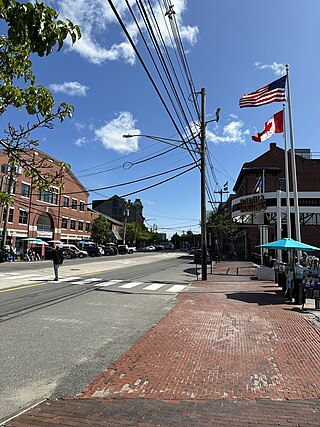
Commercial Street is a downtown street in the Old Port of Portland, Maine, United States. It is part of U.S. Route 1A. It became the Old Port's waterfront in the early 20th century, replacing Fore Street, after land was reclaimed from the waters of Casco Bay and the Fore River.
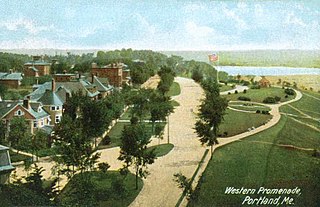
The Western Promenade is a historic promenade, an 18.1-acre (7.3 ha) public park and recreation area in the West End neighborhood of Portland, Maine. Developed between 1836 and the early 20th century, it is one Portland's oldest preserved spaces, with landscaping by the Olmsted Brothers, who included it in their master plan for the city's parks. The promenade was listed on the National Register of Historic Places in 1989.

The Fidelity Trust building is a historic office building in Monument Square, Portland, Maine.

The Press Herald Building is a historic building in Portland, Maine, built in 1923 and expanded in 1948. It is strategically located across Congress Street from Portland City Hall. It was occupied by the Portland Press Herald newspaper until 2010. In 2015, the renovated building reopened as the Press Hotel.

The Printers' Exchange Block is a historic commercial building located at 103–107 Exchange Street in the Old Port of Portland, Maine. The building, which was designed in 1866 by Charles Q. Clapp, was built the same year. It wraps around the block that stands at the intersections of Exchange, Federal and Market Streets. Its alternative addresses have been given as 174–178 Federal Street and 114–116 Market Street during its history.
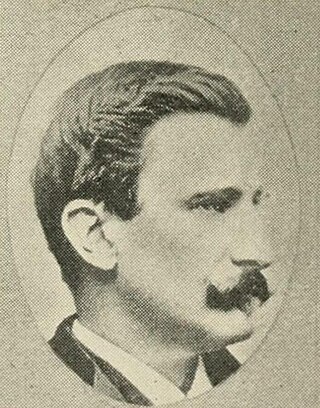
Francis Laurens Vinton (1835–1879) served in the Union Army during the American Civil War. As colonel he commanded the 3rd Brigade of Howe's division at the Battle of Fredericksburg, and was very badly wounded. He never saw active service again, but in 1863 he was appointed brigadier general.

Fore Street is a downtown street in Portland, Maine, United States. Dating to 1724, it runs for around 1 mile (1.6 km), from the Eastern Promenade on Munjoy Hill in the northeast to Pleasant Street in the southwest. Near its midsection, Fore Street crosses Franklin Street. It splits briefly at Boothby Square, shortly after passing the United States Custom House. The street passes through the Old Port district.

The Samuel Butts House is a historic colonial-style building in Portland, Maine, United States. Located in Boothby Square, on Fore Street, the building was completed in 1792, when Fore Street was at the shoreline of the Fore River estuary. It is the second-oldest extant building on the Portland peninsula, after the Wadsworth-Longfellow House, which pre-dates it by around six years. It is believed its third storey was added well after the building was completed.
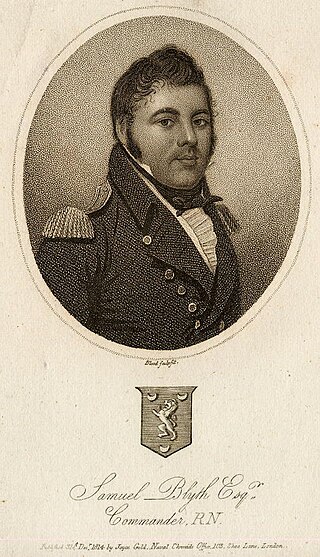
Samuel Blyth was a British sea captain. He was captain of HMS Boxer during the War of 1812, during which he was killed in action.
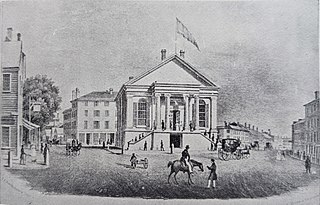
The Old City Hall of Portland, Maine, was located in what was then known as Market Square or Haymarket Square between 1833 and 1888, when it was demolished. In 1862, it was replaced by an earlier version of the City Hall located today on Congress Street, a short distance northeast of the original location.

Middle Street is a downtown street in Portland, Maine, United States. Dating to 1724, it runs for around 0.46 miles (0.74 km), from an intersection with Union Street, Spring Street and Temple Street in the southwest, to Hancock Street, at the foot of Munjoy Hill, in the northeast. It formerly originated at what was then known as Market Square, but 20th-century redevelopment saw the section between Monument Square and Free Street pedestrianized, and the remaining section—around The Maine Lobsterman monument on Temple Street—erased.

Portland station was a passenger rail station on the Grand Trunk Railway in Portland, Maine, United States. It stood to at the foot of India Street, Portland's first street, between 1903 and 1966. It was one of Portland's four railroad stations for the Portland and Forest Avenue Railroad Company over its history, and one of the two stations in the city at the time of the station's construction. The other was Union Station, which has also been demolished.
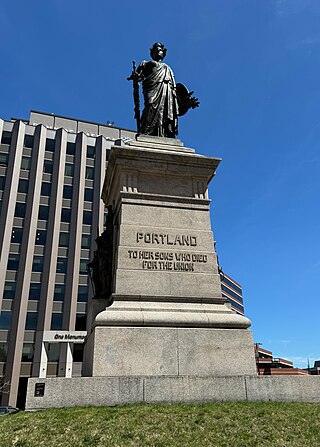
The Soldiers' and Sailors' Monument is a monumental statue located in Monument Square, Portland, Maine, United States. Dedicated on October 28, 1891, it honors "those brave men of Portland, soldiers of the United States army and sailors of the navy of the United States who died in defense of the country in the late civil war". The monument's base has the inscription Portland: To Her Sons Who Died for The Union.

Bramhall was a mansion in the Bramhall neighborhood of Portland, Maine, United States. Completed in 1858, it was owned by John Bundy Brown, an industrialist. The mansion, which was designed by New York City architect Charles A. Alexander, stood behind today's 147–163 Western Promenade, near which he also built homes for his children. After Brown's death, the mansion, which was the largest residence in Portland, was demolished. The 10 acres (4.0 ha) of land bounded by Bowdoin Street, Pine Street, Vaughan Street and Western Promenade was sold parcel by parcel, and the present neighborhood was built. The area is now part of the Western Promenade Historic District.
References
- ↑ "Historian and author to speak at South Portland Historical Society". Press Herald. 2023-11-20. Retrieved 2024-05-21.
- ↑ "Was life in Maine better 100 years ago? A historian answers in two words". newscentermaine.com. 2024-02-21. Retrieved 2024-05-21.
- 1 2 "Hometown Reads". 2021-09-25. Archived from the original on 2021-09-25. Retrieved 2024-05-22.
- ↑ "Paul J. Ledman". lawyers.justia.com. Retrieved 2024-05-21.
- ↑ In the Matter of the Petition of Paul J. Ledman, Officer of Blazing Eagles Corp. – State of New York Tax Appeals Tribunal
- 1 2 "Portland Maine: Connections Across Time | Longfellow Books". www.longfellowbooks.com. Retrieved 2024-05-21.
- ↑ Bennett, Troy R. (2023-07-12). "How Portland has been shaped by its past". Bangor Daily News. Retrieved 2024-05-21.
- ↑ "Greater Portland Landmarks - Calendar of Events". Greater Portland Landmarks. 2023-06-14. Retrieved 2024-05-21.
- ↑ Publishing, Next Steps; Ledman, Paul J. (2003). A Maine Town Responds: Cape Elizabeth and South Portland in the Civil War. Next Steps Publishing. ISBN 978-0-9728587-0-0.
- ↑ Ledman, Paul J. (2016-07-20). Walking Through History: Portland Maine on Foot. Next Steps Publishing. ISBN 978-0-9728587-1-7.
- ↑ Ledman, Paul J. (2023-06-10). Portland Maine: Connections Across Time. Next Steps Publishing. ISBN 978-0-9728587-2-4.